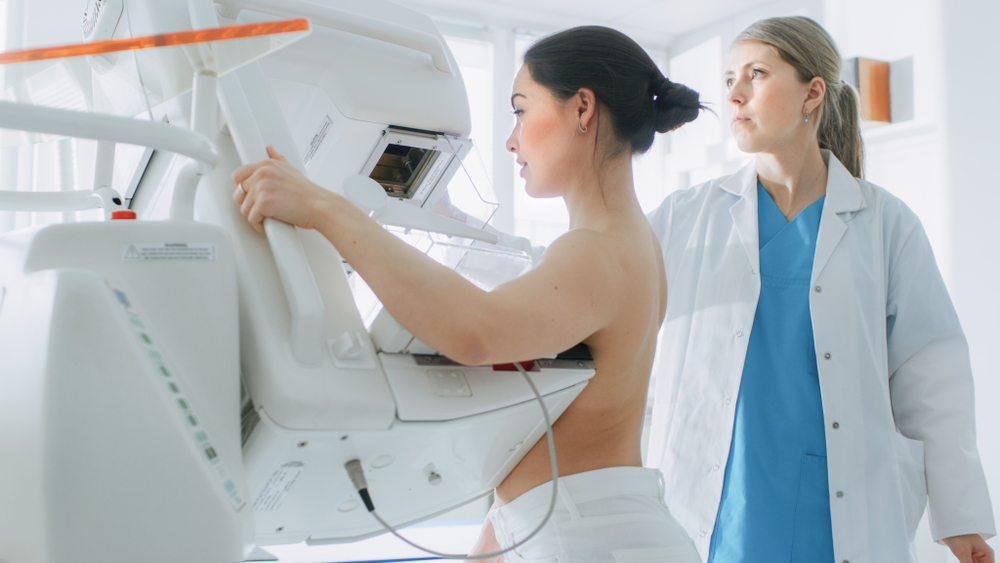Breast cancer is the most commonly diagnosed cancer among women, but technology and research have greatly improved outcomes over the last 4 decades. Though many risk factors for breast cancer may be beyond your control, the importance of mammograms for early detection of breast cancer cannot be understated.
Breast Cancer Screening Benefits
Scheduling a breast cancer screening for the first time can feel overwhelming, but regular mammograms play a crucial role in your breast health. Early detection through mammograms offers peace of mind, helping to catch any potential issues before they develop further.
Treatment Options
Mammograms allow doctors to identify changes in the breast tissue early on, often before any noticeable symptoms appear. When caught early, treatments such as lumpectomies, hormone therapy, and targeted therapies are often less invasive and very effective. Addressing breast cancer in its early stages may help reduce the need for more extensive treatments, such as mastectomies or more aggressive therapies. Survival and Recovery
For breast cancer detected in its earliest stages (Stage 0 or Stage 1), the five-year survival rate is nearly 99%. These patients often experience a shorter and easier recovery, with less intensive treatment needed. Even at later stages, like Stage 2 or 3, survival rates remain high at about 86%. The earlier the cancer is detected, the more manageable the treatment and recovery process can be.
Patient Empowerment
Taking control of your breast health through regular screenings is a powerful thing. Breast cancer, like most serious health conditions, is frightening because it involves a lot of unknowns. Regular breast cancer screenings give you the information you need to make informed decisions. Even if your mammogram is abnormal, early detection improves outcomes and widens options, allowing you to make the best decisions for your health.
Mammography Schedules
The frequency of suggested breast cancer screenings for women depends on several factors. Below is a summary of current recommended guidelines. It is important to discuss your medical history and other risk factors with your doctor to decide if this schedule fits your needs.
Age-Specific Breast Cancer Screening Guidelines
The Society of Breast Imaging and the American College of Radiology recommends the following breast cancer screening schedule:
- A risk assessment by age 25 to determine if screening earlier than age 40 is needed.
- Women at average risk, begin annual breast cancer screening at 40
- Women continue screening past age 74 unless severe comorbidities limit life expectancy.
Breast Cancer Screening For High-Risk Patients
Having a formal risk assessment is the best way to uncover your personal risk for breast cancer. You can take a self-assessment or ask your doctor to run a risk assessment on you. The risk assessment will review your risk for breast cancer as a percentage. If it reveals you are 20% or higher, you are considered high-risk.
The importance of mammograms is even more pronounced for patients at a higher risk for developing breast cancer. The American College of Radiology (ACR) recommends that women with a higher-than-average risk start an annual mammogram schedule at age 30. Some patients with a family or personal history of breast cancer or other risk factors may need additional screening modalities beyond a mammogram alone.
Breast Cancer Screening For Dense Breasts
Dense breast tissue can make it difficult to spot cancer on a mammogram. Women with dense breasts are often advised to supplement their mammography schedule with breast MRIs or breast ultrasounds. The only way to determine if you have dense breasts is to have a mammogram. Once you have your first mammogram, you’ll know your density and can have a conversation about which screening modalities in addition to mammography are right for you.
Early Detection Strategies
There are many ways to ensure early detection of breast cancer:
- Regular breast self-examinations to check for breast lumps or changes
- Regular Mammograms according to the above schedule
- Routine health checkups with your primary care provider
- Monitor your breast cancer risk factors
Imaging Technology For Early Breast Cancer Detection
The breast imaging methods used on each patient depend on several factors such as age, health, risk factors, cost, and availability. The most common imaging technologies for early breast cancer detection include:
Mammograms
Mammograms are the most commonly used breast imaging technology for early detection of breast cancer. When mammograms are unclear due to dense breasts or other imaging complications, your doctor may recommend additional imaging.
Breast Tomosynthesis (3D mammography)
3D mammography uses the same basic technology as traditional mammograms, but it captures images from multiple angles, creating a 3-D image that makes screening more effective for dense breast tissues.
Breast MRI
Breast MRIs are often recommended for patients with high risk factors and/or dense breasts since they provide powerful and detailed images. MRIs are generally unnecessary and cost-prohibitive for patients with low to average breast cancer risk.
Breast Ultrasound
Breast ultrasounds use high-frequency sound waves to create real-time breast imaging without radiation. This method is helpful for dense breast tissue but may not detect small tumors or microcalcifications that are often the earliest signs of breast cancer.
Molecular Breast Imaging (MBI)
MBI is a powerful breast cancer detection method that injects a radioactive tracer into a patient’s bloodstream to find abnormal cells. MBI is effective at detecting cancers that are missed with other screening methods, but it is cost-prohibitive and not as readily available as other screening methods.
Start Breast Cancer Screening Now
Thinking about breast cancer may be frightening, but early detection is the key to optimal health outcomes. Contact your medical provider today to discuss the importance of mammograms for early detection of breast cancer. Follow our women’s health blog for more information about research and education on breast cancer and other women’s health issues.




























![monitoring breast density shutterstock_1299510538-[Converted]](https://magview.com/wp-content/uploads/2023/05/shutterstock_1299510538-Converted.jpg)


















